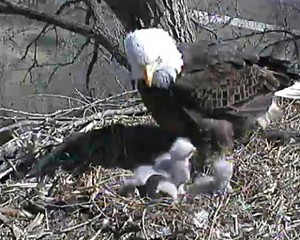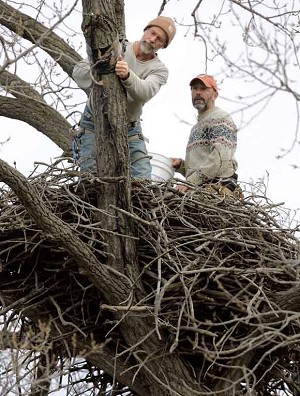Eagles In Iowa?
By Sandy Hagen
For the past two months I’ve been sharing my office with a family of five from Decorah, Iowa…a family of eagles that is.
A friend sent me a link to this web site that has since gone viral on UStream and more than 98,000,000 viewers have logged in to watch 3 little eggs hatch, grow and prepare for adult ‘eaglehood’. I cannot stop watching this family and they are with me on my computer everyday.
I have been so intrigued that after watching these eagles survive a late spring snowstorm, I called The Raptor Resource Project (RRP) and talked to their Director, Bob Anderson. Bob started the program three years ago and is also responsible for initiating the installation of the cameras and operates them most days.
I have learned so much about eagles from my daily visits to the RRP chat room (like when the egg starts to crack it’s called a ‘pip’). I had to call the Raptor Resource Project to learn more about these new Internet superstars. Here is a little bit of history and insight from my 20-minute chat with Bob:
Tee Times: What is your background and how did you get started with this program?
Bob Anderson: I started out with Peregrine Falcon’s to restore them from extinction. I worked with Xcel Energy to place the world’s first power plant nest box 400 feet above the ground on Xcel’s King Plant stack in Oak Park Heights, MN right on the St. Croix River. We were even able to install a video camera in the Xcel Energy offices for the employees to watch the nest. In 20 years, the idea has spread to power plants around the world. The Peregrine Falcon was on the federal endangered species list until 1999. Only a handful of Peregrines were left when the power plant program began. Now falcons are migrating from power plants back to the river bluffs that were once their natural habitat. As a result of this success, I was asked to set up a camera in this eagles nest five years ago to film the documentary “American Eagle” for PBS. It has snow balled from there.
TT: Where does the funding come for this project?
BA: Well RRP is a non-profit and most of the funding has come from Xcel Energy and myself. With the success of the Falcon Program, Xcel Energy hired me as a Consulting Biologist and I could then pay for the cameras, etc. Now with the success of the Decorah Eagle Cam we have received an overwhelming amount of donations. We have enough funding now for ALL of our conservation work for years.
TT: When will the babies leave the nest?
BA: Around the 4th of July. We will keep the camera on until the middle of July and then shut it off. The parent eagles will keep an eye on the eaglets until the middle of September then the babies will disappear and start their own lives.
TT: When will the adult eagles return to the nest?
BA: They start the courtship all over again around November 1st. They will spruce up the nest and make it even larger. Eagles “add-on” every year to their nest. This particular nest was used with the male eagle’s first mate. She died about 4 years ago. He now has mated with this female for 3 years.
TT: You climbed 80 feet to this nest in a cottonwood tree. What time of year is it safe to do this so the eagles don’t know you were there?
BA: Eagles have a terrible sense of smell so they will not know we are there unless they see us. The safest time to get into the nest is in October. We spend an entire day changing out the camera, microphones etc. This is the first year we have had a PZT (pan, zoom, tilt) camera.
TT: Did the nest smell bad?
BA: No, not at all even though there was a dead fish next to me. (laughing)
TT: Over 70,000,000 people from around the world have viewed the eagle family. Why do you believe this has become the phenomena it has?
BA: I am getting a universal message from around the world. We’re giving people something that doesn’t involve terror, politics or any kind of negativity. It’s a learning experience that is full of excitement and joy with lots of laughs. I think it is filling a void that the world wants. Also the technology has just become available to stream this to every part of the world. Last year, with a T1 line from Luther College, everything was running great until 300 people logged on at the same time and it crashed. Now with UStream we can have a live picture with live audio and have 80,000 people logged in and it works great.
TT: Bob thank you so much for your insight into this wonderful project.
BA: Can I just say one more thing? There would be no RRP project without a person named Amy Reis. Amy is in Minneapolis; she is our web master and a cliff climber. She repels buildings to check on nests of falcons. She is a mother and works a full time job. There would no RRP project without Amy’s volunteerism. Also Neil Rettig, who also climbs and repels with all of us. He has won several Emmy’s for his cinematography work. Everyone at RRP is a volunteer and we have all come together for a similar interest…these beautiful birds.
So, if your not one of the 70 million plus viewers who have tuned into the UStream video of this Decorah eagles nest, I invite you to come out from under your rock and check them out…before they “fly the coop”.

Mom and eaglets



